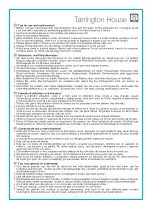
Diagram 1:
Ideal Placement
Before installing your Inwall Speakers, you should consider
their placement carefully, taking into account the location of
electrical, plumbing and other fixtures. Contact your Dealer
for assistance if you are unsure of the best location for your
particular listening environment.
Placement In Wall: When placing your speakers into the wall,
ideal sound will be achieved when the tweeters are placed at
ear level or slightly higher and the primary listening area is
no closer to the wall than the distance between the speakers
themselves. (See Diagram 1)
If the speakers are positioned far away from the primary
listening area, simply adjust the pivoting tweeters so they are
pointed towards it.
Note:
To avoid possible damage to the pivoting tweeters, read the
section entitled
“SPEAKER ADJUSTMENTS”
in this manual prior to
performing the tweeter adjustment.
SPEAKER PLACEMENT
New Construction - Unfinished Walls
A Pre-Construction Bracket, available from your Dealer, may
be installed prior to drywall application across studs (up to
24" on-center) where a speaker will be located. After the hole
is cut and the drywall is installed, the speakers are then easily
installed following the instructions for mounting in
“Finished
Walls”
below. Note:
If the speakers are to be mounted more
than 24" on-center, a special “Extra Long Wing” is available
from your Dealer.
Finished Walls
Prior to the actual installation of the speakers, it will be neces-
sary to run cables to the speaker locations. See your Dealer for
more information about cable installation. After the cable has
been properly installed, you are ready to mount the speakers.
Following the simple steps listed below will result in a profes-
sional looking installation:
1. Determine the best area to mount your speakers. This area
of the wall should be free of obstructions such as electrical
conduit, HVAC ducts, or water lines. This can best be deter-
mined by noting the placement of fixtures and gaining
access to an attic or crawl space for further analysis of the
location of such obstacles.
2. Find the studs nearest the desired speaker mounting
location. We highly recommend using a good stud-finder
tool for this procedure. If you are lining up the speakers to
some other object or molding in the room, make sure you
consider the size of the baffle, which extends beyond the
mounting hole.
3. Mark the hole. A template for setting the hole is provided in
the box. Position the template in the desired position and
pencil an outline on the wall.
4. Cutting the hole. CAUTION: This is the most important part
of the entire installation. If you are not certain whether any
obstructions exist behind the desired mounting area, you
should start by cutting a small hole in the center of your
penciled mounting hole with a drywall saw, cutting at a 45°
angle towards the inside of the hole. (See Diagram 2) Cutting
the small hole at this angle will make drywall repair much
easier, using the piece cut out. Once you have determined
that there aren’t any obstructions in your desired mounting
location, start cutting the finished hole at a 90° angle to the
wall surface.
5. Add insulation. If the area in the wall is not already
insulated, add an adequate amount of insulation material to
loosely cover the back of the speaker. If the insulation mate-
rial used is faced with foil or paper, position the foil or paper
away from the speaker.
CAUTION: Speaker components can get hot while playing
music at moderate to high volume levels. There should be
nothing at all touching the speaker. Material in proximity to
the back of the speaker must have at a minimum 1" or 26mm
clearance for non-flammable materials and more for flamma-
ble materials like plastic vapor barriers.
MOUNTING SURFACE PREPARATION
Diagram 2:
Wall Cut Out
Inwall Speakers
W852 • W802 • W692 • W682 • W672 • W667
OWNER’S MANUAL






















